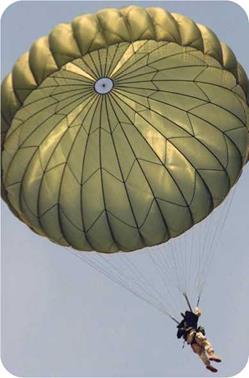The Invention of the Parachute
Even a handkerchief will act as a parachute if strings are tied from each corner to a small weight. The idea may have struck someone far back in history. The Chinese invented the umbrella, and they may have adapted the umbrella shape to try parachuting 1,000 years ago. In around 1485, Italian artist and inventor Leonardo da Vinci drew a cone-shaped
|
О A drawing from the early 1800s shows three views of Andre Jacques Garnerin’s 1797 parachute: the top, the release from a balloon, and the parachute floating down after release.
|
parachute, but it is not known whether his device was ever tested.
The first parachute jumps recorded in Europe were made in 1783 by Sebastien Lenormand of France, who dropped weights and animals from a tower using a parachute that looked rather like a lampshade. In 1797, Andre Jacques Garnerin made a circular parachute of cotton cloth, from which hung a basket for a passenger. On October 22, 1797, he and his parachute were carried aloft by a balloon. Garnerin descended safely from about 2,000 feet (610 meters) above the city of Paris.
In the nineteenth century, parachute jumping from balloons became a popular form of entertainment. Balloon jumper Charles Broadwick invented the first body-pack parachute in 1905. The parachute pack was fastened to the balloon by a line. As the jumper fell, the line tightened and pulled the parachute canopy open. In 1912, Captain Albert Berry made the first parachute jump from an airplane, at a height of 1,500 feet (460 meters) above St. Louis, Missouri. Georgie Thompson, a teenager who jumped with Broadwick, was the first woman to jump from an airplane and land using a parachute, in 1913.
During World War I (1914-1918) few pilots had parachutes. Generals (and many pilots) argued that parachutes were too cumbersome. Military personnel who went up in observation balloons did have parachutes, however, so they could leap out if their balloons were hit by enemy gunfire.
HOW A PARACHUTE WORKS
When a parachute opens, air pushes up to fill the canopy. The air acts against the force of gravity and slows the fall of the object to which it is attached. A parachute increases air resistance because it offers a large surface area that produces friction with the air. At first, friction is greater than gravity, so the parachutist slows down. When the friction decreases to the point at which it is equal to the force of gravity, the parachutist descends at a constant speed. In certain weather conditions, the upward force of air may push the parachutist upward for a short time.
|
|












